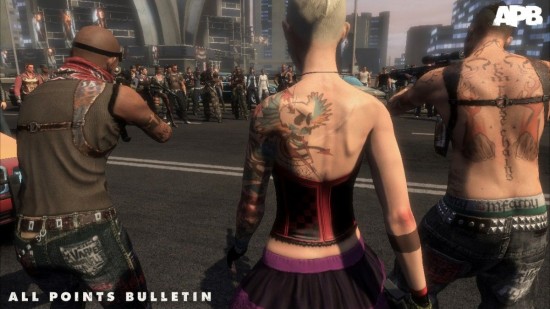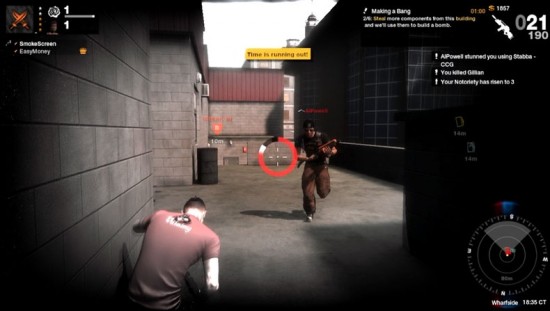If you work in the games industry, you’re probably already somewhat familiar with APB. It’s known as the hundred million dollar bust that sank Realtime Worlds, and it’s easily the biggest failure story in MMO history. It was almost universally panned by critics, and most gamers stayed far away from it.
But you might also remember a time when the game was the one of the most anticipated titles around – back when it was revealed at GDC 2008, in a presentation by GTA creator and RTW CEO Dave Jones. That presentation happened to be the first talk I ever attended at a GDC, and it left an impression on me. I remember the entire room erupting with applause and cheers every time they showed a new feature in the character customization system. I remember the people around me instantly calling it a “WoW killer.” Then it suddenly disappeared from the media, and we heard almost nothing about it in the two years between that talk and its release. I’m not an MMO fan, but I really looked forward to APB.
I was working at Visceral Games when it came out this summer, and everyone in the office was shocked by the beating it took on Metacritic. We all wanted to play it to see the damage for ourselves, but due to the reviews none of us wanted to actually buy it. The cycle of doubt fixed itself when my lead presented me with a copy of APB as a going away present on my last day of work. I played it, analyzed it, and tried to come up with some insights that can be gained from it.
APB: All Points Bulletin
Developer: Realtime Worlds
Publisher: Electronic Arts
Genre: Shooter / MMO
Metacritic: 58
Price: $49.99
Subscription: $7/20hrs or $10/month
Background
APB is the first (and last) MMO by Crackdown developer Realtime Worlds. It places players in the city of San Paro, a modern metropolis where criminals roam the streets and everyday citizens have been given the go to bring them to justice. Players can choose which side to align with – “enforcers” or “criminals” – and do their part to eliminate the other faction. The premise is simultaneously obvious, awesome, and vastly underdeveloped for the genre. Cops vs Robbers is fun, and you could say the theme has proven to be mildly successful in games, so why not make it into an MMO?
World
Remember the description above, where I said San Paro was a “modern metropolis?” APB only lets you visit three areas of it, none of which are terribly large. The game has two “action districts” (Financial and Waterfront) and one “social district.” The action districts are where you’ll find PvP gameplay, and the social district consists of very little socializing but is free to play and doesn’t eat up game time. It’s also where you go to buy items for your character. The district select menu comes up when you login to the game, and it pretty much sticks to expectations for the game’s overall lack of polish.
The social district looks fine, and has a few cool features to boot. It reminds me of the few things that don’t suck about Second Life in that players can buy ad space on billboards with in game currency, create content such as clothing designs and songs, and sell them in a marketplace. I found its layout to be somewhat annoying because it forces the player to run from one end to the other to go from customizing a car to customizing a shirt. If players actually spent time there talking or doing in-game activities, it might be different, but as it was, it was nothing more than silly filler. It spits in the face of the MMO’s fiction, claiming that “nobody knows how or why” there’s no fighting in it, but sure, let’s give them the benefit of the doubt.
The action districts are where actual gameplay happens, and where players spend their prepaid game time. I’ll elaborate more on the gameplay in a  bit, but the world’s themselves deserve a bit of attention here. Both action district maps are fairly small, but they’re very well designed. The layouts are intuitive and make for interesting fights and cover situations, with a focus on navigating both the interiors and exteriors of buildings, from the basements to the rooftops. They feel like the open worlds they need to be. Graphically, they leave a lot to be desired – they’re rather bland in comparison to the player-managed social district, and the environment looks particularly out of place when filled with player-created content like avatars and cars.
Customization
With its robust customization engine, players only have to take the APB as seriously as they want to. The character creator lets you be anyone from a jacked-up, tatted-out gang member to an overweight soccer mom, and the car editor lets you make a matching sportscar or minivan to boot. The game features multiple editors that can be accessed from different computer terminals in San Paro’s Social District. If you haven’t seen a demo of this customization engine before, you owe it to yourself to check it out:
APB puts every other game with a character editor to shame. I was previously enthralled by the editor in City of Heroes, and this makes it look like a piece of crap. It’s absolutely unbelievable how easy it is to make something awesome with the tools they give you. I spent over an hour creating my character before I even got into the game because the designer in me was having so much fun.
It’s even more unbelievable to me that this piece of the game is so polished and feature complete in the face of everything else. It feels like a completely different game.
Gameplay
At its core, APB is a driving and shooting game. Reviewers complained that neither driving nor shooting controlled particularly well, and therefore it was broken. It’s true that the controls are a bit weird, but then again, it’s an MMO. I can live with a little bit of lag if everyone else is having it too. The controls aren’t too bad if you take the time to get used to them.
Perhaps the bigger problem is that there isn’t a lot of variety outside of driving and shooting. In the game’s tutorial, you run up to a fence and press the “F” key to vault over it with a fluid animation. Then you walk up to a door and press the same “F” key to diffuse a bomb – an animation so laughably bad that the character sometimes even faces the wrong way or doesn’t touch the bomb in question. I’m not knocking the game for using context sensitive actions, but when you find out that nearly every mission in APB is based on running up to doors and holding “F” or preventing someone else from holding “F,” all with terrible animation, the game’s world falls apart.
When inside an action district, you press a “ready” key to be able to receive missions. Sometimes it takes as long as five or ten minutes for a mission to be delivered to you, and there’s nothing to do in the interim apart from customizing your weapon loadout or exploring the environment. You’ll either be assigned to a group mission, start a new mission, or sent to prevent an enemy team (cops or robbers) from completing a mission. This is where the game shines.
Being sent out to prevent other players from completing objectives feels great. Players from all over the city are called to a central location via the GPS. You can hop in a car with another player or drive on your own. There’s a ton of strategy for players to use, and teams actually have to work together to accomplish anything. A team trying to complete an objective might send someone out on the rooftop of a building to scout for enemies, and a team trying to stop an objective might try to flank the target site from multiple angles to prevent access. APB delivered on its promise with that experience.
If you die, you respawn close to the action. Fail cases are objective-based in relation to targets on the map or in relation to what are essentially miniature team deathmatch games, such as a case where the first team to 10 kills wins. Respawning so quickly feels odd in an MMO setting, but reveals the game’s deathmatch roots. That’s really all APB’s gameplay boils down to – team deathmatch inside an MMO, but it brings out the best in team deathmatch.
The game’s brilliance fades as quickly as it comes. Once one team wins, all players become neutral again regardless of team affiliation. There are obvious gameplay implications for doing it this way, but if the fiction and the gameplay demand for me to arrest or eliminate criminals as an enforcer, it doesn’t make sense that I suddenly can’t hurt them at all and we go our separate ways. APB reveals itself as a buddy cop fantasy, where you and your friends can be Jackie Chan and Chris Tucker, but then you have to turn around and let the bad guys get away just when things start to get tough.
Conclusion
Even though I was annoyed by quirks with the gameplay, I kept playing APB because of the customization engine. I always wanted to reach the next level to unlock the next car or the next cool piece of clothing for my avatar, and seeing other players running around with the best equipment served to reinforce that. Realtime Worlds wasn’t kidding when they said no two players will look the same in APB, and that’s the coolest part of it. It’s just a shame that there’s not much to do with your character or your car once you have everything customized the way you want.
I feel like this game would be more fun if it wasn’t an MMO – that feeling of emptiness after a mission wouldn’t happen if there was no persistent world. Toss 32 players (16 cops / robbers) into a huge map with the objective-based gameplay, but end it once one team wins and start a new round. Keep all of the customization options locked into a menu system outside of gameplay. It’s GTA meets Team Fortress, and the MMO part seems to get in the way.
The rights to APB have been purchased by a free-to-play game company, and it should be back online sometime early next year. I’ll write a little update when I have a chance to get back in the game and see what changes they’ve made.



0 Comments
Trackbacks/Pingbacks